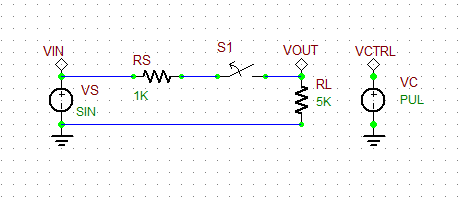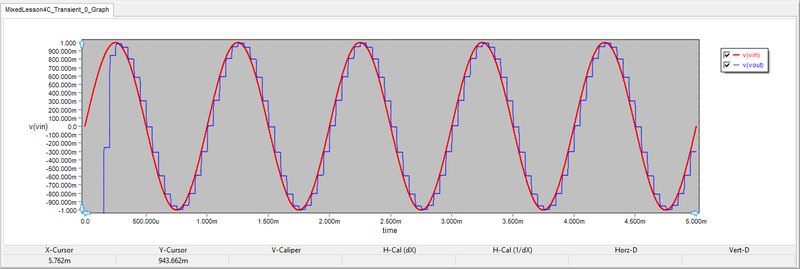Mixed-Signal Tutorial Lesson 4: Designing Sample-And-Hold Circuits
Contents
What You Will Learn
In this tutorial you will use SPICE's standard voltage-controlled switch as well as a semiconductor FET switch to sample signals and build sample-and-hold (S/H) circuits.
Using the Voltage-Controlled Switch to Sampling Signals
The following is a list of parts needed for this part of the tutorial lesson:
| Part Name | Part Type | Part Value |
|---|---|---|
| VS | Voltage Source | Waveform TBD |
| VC | Voltage Source | Waveform TBD |
| RS | Resistor | 1k |
| RL | Resistor | 5k |
| S1 | Voltage-Controlled Switch | Defaults |
| VIN | Voltage Probe Marker | N/A |
| VOUT | Voltage Probe Marker | N/A |
| VCTRL | Voltage Probe Marker | N/A |
The voltage-controlled switch with the keyboard shortcut S is a two-pin device, whose ON and OFF states are controlled by an external voltage defined in the switch's property dialog. VS is the signal source with a sinusoidal waveform. VC is the control source with a pulse waveform, which will control the opening and closing of the switch S1. Open the property dialog of the switch and set its On Voltage and Off Voltage to 4.5V and 0.1V, respectively. These are the threshold values for the control voltage. Set the On Resistance and Off Resistance values of the switch to 1u and 1G, respectively. Finally, set the Controlling Voltage by choosing "VC" from the drop-down box labeled "Voltage across part".
| |
Always set a nonzero value for the On Resistance of the switch. Otherwise, a zero resistance may lead to simulation failure. |
Place and connect all the parts as shown in the figure below:
Set the waveforms of the two voltage source VS and VC as specified below:
|
|
Run a Transient Test of this circuit with the parameters specified below:
The results are shown in the figure below. As you can see from the figure, every 3ms the switch closes for a duration of 1ms, and the source voltage is transferred to the resistive load through the voltage divider. Your sinusoidal input signal is clearly under-sampled. Next, change the period and pulse width of the control source according to the table below. Run another transient test with the same parameters. You can see from the figure below that each period of your is sinusoidal input signal is sampled 10 times.
Building a Basic Sample-And-Hold CircuitAdding a shunt capacitor C1 to the load of your sampling circuit above will make a basic sample-and-hold circuit as shown in the figure below. During the ON state of the switch (Sample Time), the capacitor C will charge to the sampled voltage value. During the OFF state of the switch (Hold Time), the capacitor will keep its held sample voltage until the next charging period. Set the capacitance initially to C1 = 50nF. Change the control pulse waveform according to the table below:
Run a Transient Test of this circuit with the parameters specified below:
As you can see from this figure, the capacitor discharges too quickly during the hold time and certainly is not able to hold the sampled voltage for the entire time. Note that the time constant of this circuit is τ = RLC1 = 250μs. Of the 50μs period of the pulse waveform, the first 25μs is the sample time, and the remaining 25μs is the hold time. Clearly, the discharge time constant is too short. Next, increase the value of C1 to 400nF. In this case, the discharge time constant will increase to τ = 2ms. Run a new transient test of the circuit with the same parameters as before, and you will get the results shown in the figure below. You can see an improvement of the performance of your S/H circuit but in exchange for lower amplitude and larger delay time. Building an Op-Amp Sample-And-Hold CircuitThe following is a list of parts needed for this part of the tutorial lesson:
Configure the two Op-Amps as voltage followers acting as buffers between the input and output as shown in the figure below. The JFET transistor J1 acts as the switch which turns on and off by the control voltage applied to its gate. The shunt charge capacitor is connected between the output of the switch and the input of the second voltage follower. Set the waveforms of the two voltage sources VS and VC as specified below:
|









